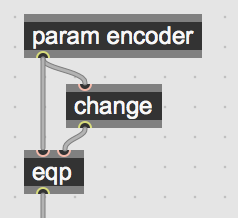Hi Sandro,
[param encoder] should give you +1 or -1 signal when the encoder is turned. There is a gotcha here though: because the analogue inputs are sampled at block rate (normally 48 samples), that will actually result in a step function. To get a single-sample trigger out of it, you could route with a [change] into [eqp] like this:

[eqp] is short for “equal-pass”: the input passes through if both inlets are equal, else it passes zero. [change] reports 1 when the input is rising, -1 when falling, and zero otherwise. So, in the frame that the [param encoder] step function goes from 0 to 1, the change also does the same, and eqp passes 1 through. In the next frame, the step function is flat, the [change] outputs zero, and thus so does [eqp]. And vice versa for -1.
Perhaps I should make an abstraction for this in oopsy, it’s likely a common need.
Then, routing this into a [+=] or [accum] (they are the same object, just different names) will give you an ‘endless encoder’ kind of value. The 2nd inlet of [+=] will reset the value to zero.